After record temperatures and drought, swaths of Pakistan lie submerged, symptoms of a climate crisis its people play little part in.
by Shah Meer Baloch in Pakistan and Matthew Taylor
Farmer Ali Bakhsh stands on an embankment and points across the flooded landscape of Sindh province towards the spot where his fields used to be. He is sheltering in a makeshift camp accessible only by boat with more than 2,000 others forced to flee their homes when the floods hit.
“There was no rain a few months back and there was a severe shortage of water for crops. We prayed for rain. But when it rained, we became homeless and our crops were destroyed. We have nothing left … just oceans on roads, on farms and submerging our homes.”
Pakistan has been battered by drastic weather extremes since the start of the year. Deadly heatwaves sent temperatures above 50C (122F) in the spring, followed by huge wildfires and crippling droughts.
But the floods that have left a third of the country’s provinces underwater in recent weeks have brought with them a new level of human misery – and a glimpse into the apocalyptic impact of the climate emergency in one of the countries least responsible for it.
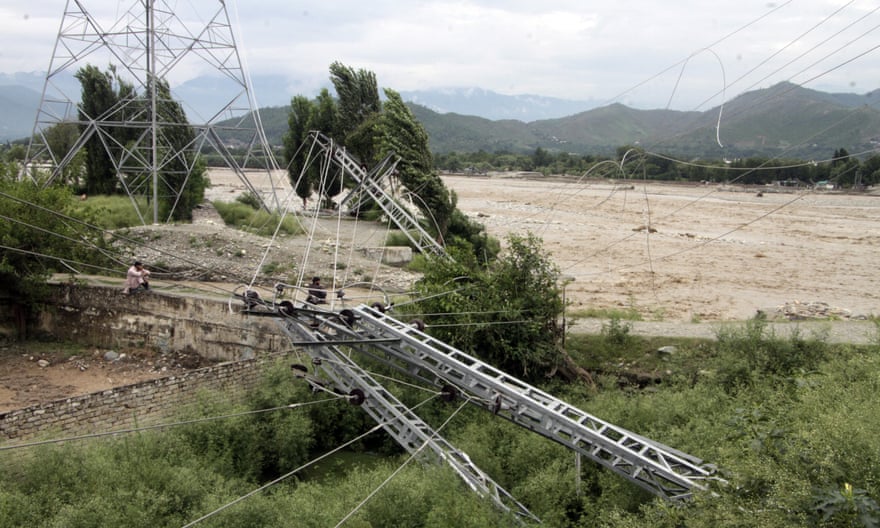
“I have seen many humanitarian disasters in the world, but I have never seen climate carnage on this scale,” said the UN general secretary, António Guterres, on a visit to Pakistan this week. “I have simply no words to describe what I have seen today.”
Super flood
The record monsoon that began in mid-June has devastated much of the country, with some areas receiving more than eight times their usual rainfall.
Torrents of water tore through villages, sweeping away thousands of houses, schools, roads and bridges and destroying 18,000 sq km of agricultural land.
In Sindh, the southernmost province of Pakistan, which produces half the country’s food, 90% of crops have been ruined, and an inland lake 60 miles (100km) wide stretches to the horizon after the Indus River burst its banks.
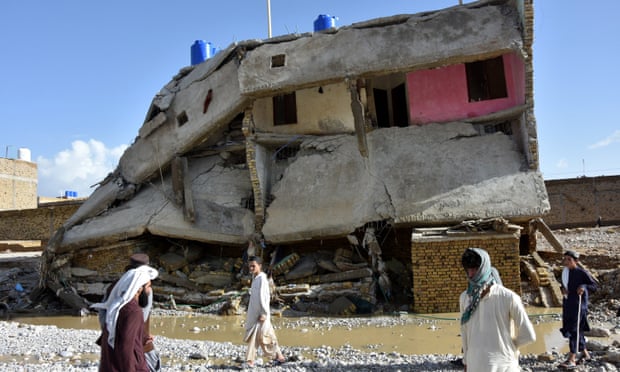
The flood is estimated to have killed at least 1,400 people. Many tens of millions more have lost their homes and livelihoods and the country has incurred huge financial costs. Damages so far have been put at $30bn (£26bn).
In the flood’s immediate aftermath, aid agencies report that innumerable children have been left hungry and dependent on contaminated drinking water for survival, while pregnant women and elderly people are crowded into makeshift relief camps and unable to access life-saving medicines. Hospitals in the worst-hit areas are overwhelmed. Medics in one district say malaria cases are rising so fast that they have run out of capacity to even test for the disease, let alone treat it.
‘We thought we’d die of hunger. Now we fear death from water’
says a flood-affected man.
As the horrors mount, a traumatised population now faces food shortages, famine and disease. Few doubt that the crisis engulfing the country will get much worse in the coming weeks and months.
“The scale of this and what is still to come for the people of Pakistan is quite chilling, to be honest,” said Farhana Yamin, a former UN lawyer who was born in Pakistan and helped to draft the 2015 Paris climate agreement. “This is not a small country, it is the fifth most populous country in the world, and it has been devastated … It will take decades to recover.
‘Ground zero’
Pakistan is responsible for less than 1% of global carbon emissions, according to European Union data, but as the last six months have shown, it is at the sharp end of the climate crisis.
The country, which was already in the throes of political and economic turmoil, has turned to the international community for help with a crisis it bears little responsibility for.
“Global warming is the existential crisis facing the world and Pakistan is ground zero,” said Pakistan’s climate change minister, Sherry Rehman. “There is so much loss and damage, with so little reparations to countries that contributed so little to the world’s carbon footprint, that obviously, the bargain made between the global north and global south is not working.”

The story of Pakistan’s climate turmoil in 2022 makes for stark reading. Early heatwaves in April sent temperatures soaring to 50C in many parts of the country, pushing up against the limits of what the human body can endure.
The deadly heat sparked a huge wildfire the following month that engulfed Shirani, the world’s largest natural pine forest, spread over 26,000 hectares and home to more than 10.8m trees. The blaze in the southwestern province of Balochistan reduced 40% of the forest to ashes.
Also in May, in the Mastung district of Balochistan, which is known for its apple and peach orchards, farmer Haji Ghulam Sarwar Shahwani watched in despair as his apple trees blossomed more than a month early before shrivelling in the heat, killing most of the fruit.
But the floods that followed the heat a month later brought a level of devastation he had never witnessed before, he said.

“It rained for weeks in July and August and then flood water coming from the mountains damaged all of my 6,000 apple trees. We could only see the top of the trees in the flooded water and they can’t grow now. We have to cut them once the flood water is drained,” Shahwani said.
Surveying his devastated orchards, which had taken him decades to build up, he said: “I have never seen such heatwaves in April in Mastung, nor such massive floods in my lifetime. It rained continuously for more than 120 hours in some areas. This much water, it seems, is unreal to me. It has washed away all we had.”
Abdul Rasool, a farmer and political activist, said many farmers had been facing drought earlier in the year and feared that their crops, such as rice and wheat, would die, only for the floods to take their place with devastating effect.
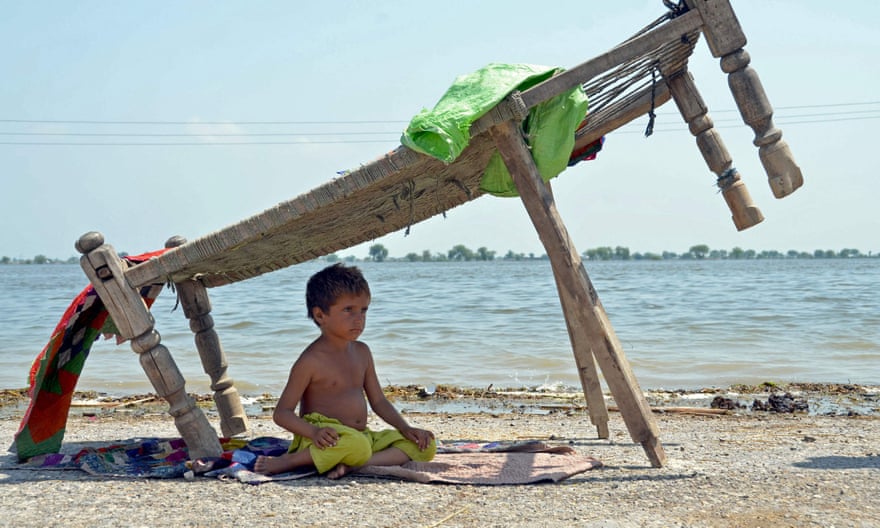
“We thought we would die of hunger, but now the floods have swept away everything and there is water as [far] as we can see. We fear death from water … It has killed hundreds of people.”
Experts say a series of deep monsoon depression systems swept across the country, with torrential rain falling day after day on steep slopes that were already saturated. This caused huge flash floods and gave people little time to escape.
Scientists have carried out an initial rapid attribution study of the disaster, a way of determining how much worse, or more likely, an extreme weather event was made by human-caused global heating. They concluded that climate change could have increased the power and severity of the flooding in the worst-affected areas by about 50%. Floods were previously a once-in-a-century event, but the study found they are likely to become more frequent in future as global temperatures continue to rise.
Climate breakdown
Yamin, who no longer works for the UN but still has family in Pakistan, said the tragedy was that a climate disaster on this scale had been utterly predictable for anyone who had been paying attention.
“We knew this sort of event was coming and have been warning about it for years,” she said. “That’s what’s so sad. Runaway climate change is happening in Pakistan, but still, it feels like that is not enough for policymakers to start taking this seriously.”
The signs of climate breakdown are all too visible across large swaths of the country. In Balochistan, the largest and most impoverished province, which covers half of Pakistan, the mountains are usually barren and dry with little or no grass…
But since the floods, lush meadows have covered the slopes, while in the valleys below there is chaos, with many of the roads and bridges destroyed.
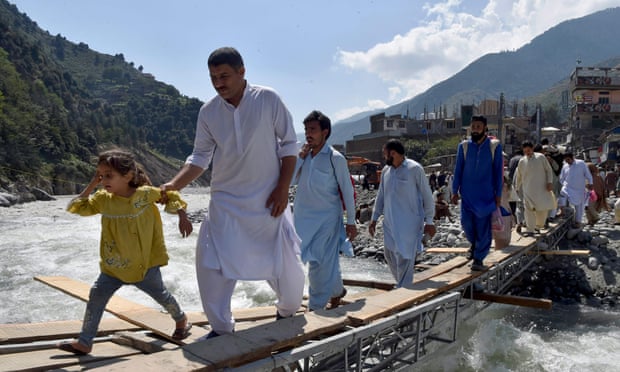
Prof Gohram Khan, the head of environmental science at the Balochistan University of Information Technology, Engineering and Management Sciences, said: “This much heavy downpours have changed everything … We were not expecting it. It was beyond the expectations of people … There is going to be destruction. Nature is going to change. It is changing so fast.”
Entire South Asia is being affected due to climate change and it is not of our own making. Rather, the industrialised and capitalised world has played the main role in this, but we are paying the price for it
Dr Bakhshal Thalho, general Secretary, The Awami Workers Party
The devastation wrought by the floods has triggered a debate about climate justice both within Pakistan and internationally.
Bakhshal Thalho, a political worker and general secretary of the Awami Worker Party in Sindh province, said that although the Pakistani authorities needed to do more, it was western countries and corporations in the global north that were driving the extreme weather through their carbon emissions.
“Entire South Asia is being affected due to climate change and it is not of our own making. Rather, the industrialised and capitalised world has played the main role in this, but we are paying the price for it,” he said.
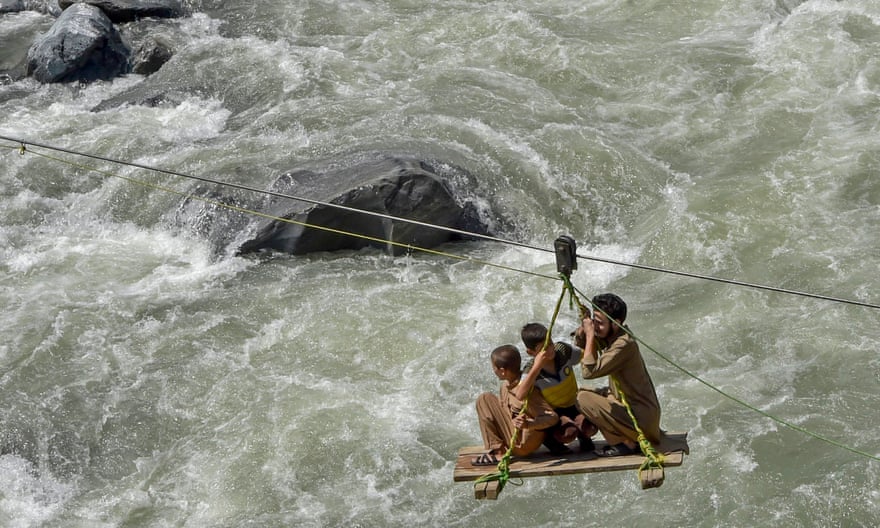
Campaigners and experts say the devastation that has hit Pakistan is a foretaste of what the world faces unless there is a rapid and concerted effort to reduce emissions and protect vulnerable countries.
“The immense tragedy in Pakistan is also an immense injustice, but the really scary thing is that this tragedy and injustice will be exceeded, again and again, in the years to come,” said Prof Simon Lewis, a climate scientist at University College London.
“The floods, heatwaves and droughts will increase until the world reduces carbon emissions down to zero. Fossil fuels were once enablers of human progress, now they destroy it. The quicker we end their use, the safer we will all be.”
Asad Rehman, a leading climate justice campaigner and director of War on Want, said governments in rich nations were trying to “solve their energy crisis, pushing ahead with huge carbon bombs, on the backs of poorer black and brown people” despite the huge human and environmental suffering they were causing.

“What we are seeing clearly in Pakistan is a toxic mix of extreme weather, inequality, and an unjust economic system that combines with colonial mindsets that devalue the lives of the world’s poorest people,” he said.
Back on the Superio embankment in Sindh, farmer Baksh, who lost all his fields, can only face the devastating reality left behind by the floods.
“People call it a climate catastrophe in Pakistan,” he said, surveying the water that stretches for miles in all directions. “I don’t know how much time it will take flood water to drain. I really don’t know when the government will rescue us from this embankment. Everything is so uncertain.” Additional reporting by Waseem Mohamed
This long read was first published in The Guardian, London

The High Asia Herald is a member of High Asia Media Group — a window to High Asia and Central Asia

